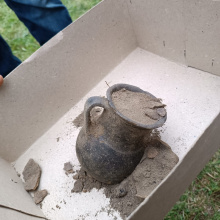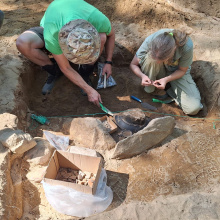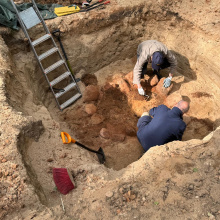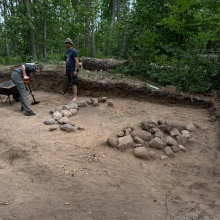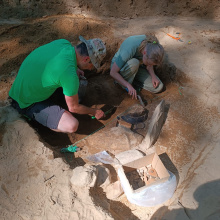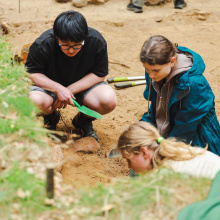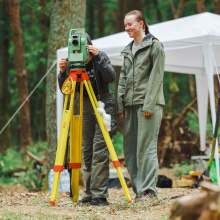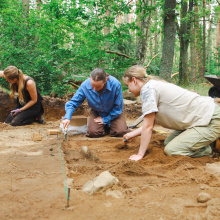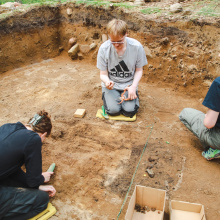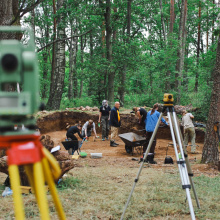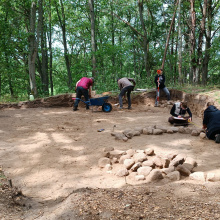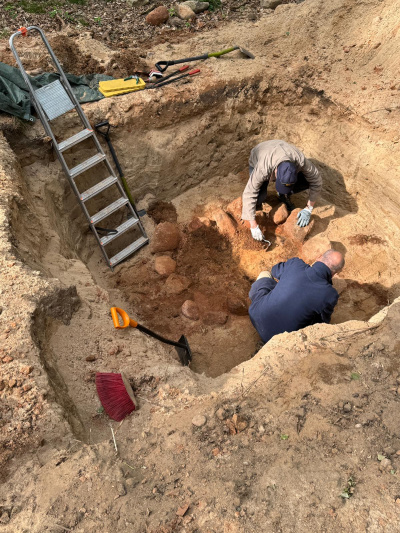
A team of archaeologists led by dr Andrzej Kasprzak (Institute of Archaeology, University of Gdańsk, and Museum in Koszalin) is continuing excavation work at the burial mound cemetery in Rekowo. The earliest traces of settlement discovered at the site in Rekowo date back to the Stone Age and the early Bronze Age; traces of Roman influence have also been found. This July, research is focusing on an object uncovered at the end of the previous season - a kiln with clay walls and a base made of large pebbles, probably an artefact of the Wielbark culture. Since the beginning of the site's existence, the seasonal archaeological work in Rekowo has been accompanied by the annual metal music festival ‘Wykopaliska’ (Excavations), which took place on July 18-19.
Archaeological work in Rekowo was started in 2023 by dr Andrzej Kasprzak as an employee of the Museum in Koszalin. Since 2024, dr Kasprzak has also been working at the Institute of Archaeology of the University of Gdańsk, which has thus become a co-organiser of the research. Students from Gdańsk and Szczecin (in previous years also from Poznań) and volunteers from various regions of Poland are participating in the work.
In the 2023 and 2024 seasons, particular attention was paid to one of the largest burial mounds at the site, measuring 15 m in diameter and 1.5 m in height. Research has shown that the mound was built in two stages: originally it was a mound with cremation graves of the Lusatian culture (c. 1200-700 BC), and then it was reused as a burial site during the Roman period (c. 70-230 AD).
In July 2025, the most interesting object was the one captured at the end of the previous season, which had not been examined at the time due to lack of time - a kiln with clay walls and a base made of large pebbles. It waited a whole year covered with foil and buried in the ground. Inside, only two fragments of pottery were found, most likely associated with the Wielbark culture. Similar structures are known mainly from settlements. What the furnace was used for and why it was located on the edge of the cemetery remains a mystery for now. Perhaps these questions will be answered by the results of specialist tests carried out on samples taken from the site.
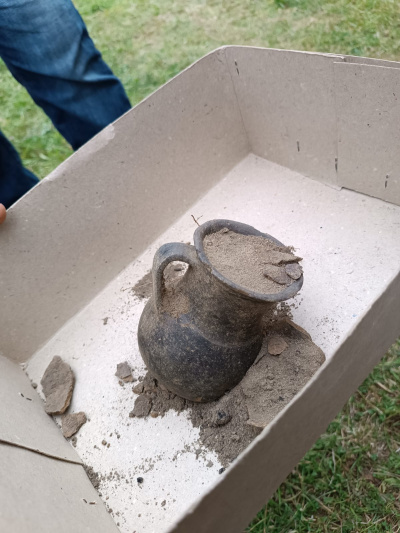
The materials collected so far confirm that the cemetery in Rekowo was multicultural and was used for many centuries - from the Stone Age (as indicated by flint tools found here, evidence of human presence around 5,000 years ago), through the early and late Bronze Age, to the times of Roman influence and even modern times, as indicated by a coin of Sigismund III Vasa found in the vicinity of the burial mound.
The ‘Excavations’ festival has accompanied the work in Rekowo from the very beginning. It is a unique event, not only on a national scale, but also worldwide, combining heavy sounds with a passion for the past. Metal bands from Great Britain, the Czech Republic and Belarus played on stage; the performances were accompanied by demonstrations of ancient crafts and archaeological lectures by eminent archaeologists: prof. Andrzej Kokowski, prof. Arkadiusz Marciniak, dr Bartłomiej Rogalski, dr Kamil Niedziółka and Maciej Marczewski. Participants had the opportunity to visit the excavation site accompanied by its leader, dr Andrzej Kasprzak, and those who were interested were also offered the chance to take part in the field research itself.
‘The idea for the festival came about partly as a result of our research. It is a private initiative, but of course we strongly support it,’ says dr Andrzej Kasprzak. ‘As a researcher at the site in Rekowo, I help organise speakers and take festival-goers to the site every year. The museum lends equipment. The festival is a great opportunity to promote archaeology, which has no equivalent anywhere else in the world.'

